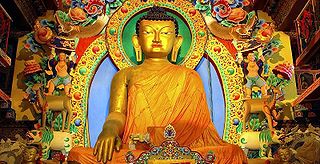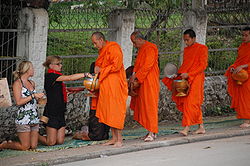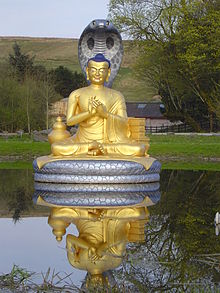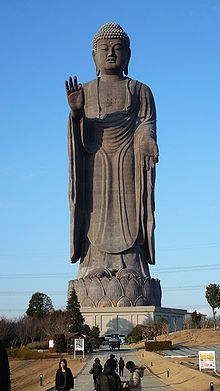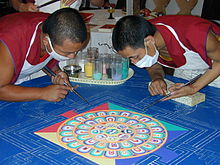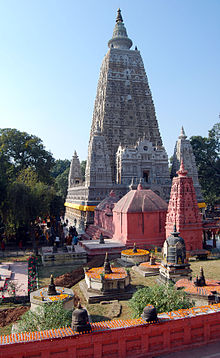- Outline of Buddhism
-
See also: Index of Buddhism-related articles
 Dharmacakra, symbol of the Dharma, the Buddha's teaching of the path to enlightenment
Dharmacakra, symbol of the Dharma, the Buddha's teaching of the path to enlightenment
The following outline is provided as an overview of, and topical guide to, Buddhism:
Buddhism (Pali/Sanskrit: बौद्ध धर्म Bauddha Dharma) — religion and philosophy encompassing a variety of traditions, beliefs and practices, largely based on teachings attributed to Siddhartha Gautama, commonly known as the Buddha (Pāli/Sanskrit "the awakened one").
The Buddha
Main article: Gautama Buddha- Tathāgata — meaning "Thus Come One" or "Thus Gone One," the epithet the Buddha uses most often to refer to himself; occasionally it is used as a general designation for a person who has reached the highest attainment
- Buddha's Birthday
- The Four Sights — observations that affected Prince Siddhartha deeply and made him realize the sufferings of all beings, and compelled him to begin his spiritual journey
- Qualities of the Buddha
- Abandonment of all defilements (kilesa — principally greed, hatred and delusion) together with their residual impressions (vasana)
- All defilements have been abandoned totally — all defilements have been destroyed with none remaining
- All defilements have been abandoned completely — each defilement has been destroyed at the root, without residue
- All defilements have been abandoned finally — no defilement can ever arise again in the future
- Acquisition of all virtues
- Great Wisdom (Mahapaññā)
- Extensiveness of range — understanding the totality of existent phenomena
- Profundity of view — understanding the precise mode of existence of each phenomenon
- Great Compassion (Maha-karuṇā)
- Great Wisdom (Mahapaññā)
- Abandonment of all defilements (kilesa — principally greed, hatred and delusion) together with their residual impressions (vasana)
- Physical characteristics of the Buddha
- Buddha footprint
- Buddha statue (Buddharupa)
- Iconography of Gautama Buddha in Laos and Thailand
- Depictions of Gautama Buddha in film
- Miracles of Gautama Buddha
- List of places where Gautama Buddha stayed
- Colours of Buddha's aura (prabashvara)
- Sapphire blue (nila)
- Golden yellow (pita)
- Crimson (lohita)
- White (odata)
- Scarlet (manjesta)
- Family of Gautama Buddha
- Śuddhodana (father)
- Māyā (mother)
- Yasodharā (wife)
- Rāhula (son)
- Mahāpajāpatī Gotamī (foster mother)
- Nanda (half-brother)
- Ānanda (cousin)
- Anuruddha (cousin)
- Devadatta (cousin)
- Teachers of the Bodhisatta Gotama
- Āḷāra Kālāma — taught Gautama the dimension of nothingness
- Uddaka Rāmaputta — taught Gautama the dimension of neither perception nor non-perception
- Gautama Buddha in world religions
Branches of Buddhism
Schools of Buddhism
Main article: Schools of BuddhismTimeline: Development and propagation of Buddhist traditions (ca. 450 BCE – ca. 1300 CE)
450 BCE[1] 250 BCE 100 CE 500 CE 700 CE 800 CE 1200 CE[2] India
Early Buddhist schools Mahayana Vajrayana Theravada Buddhism Tibetan Buddhism East Asia
Chán, Tiantai, Pure Land, Zen, Nichiren Shingon
450 BCE 250 BCE 100 CE 500 CE 700 CE 800 CE 1200 CE Legend: = Theravada tradition = Mahayana traditions = Vajrayana traditions Theravāda
Theravada — literally, "the Teaching of the Elders" or "the Ancient Teaching", it is the oldest surviving Buddhist school. It was founded in India. It is relatively conservative, and generally closer to early Buddhism,[3] and for many centuries has been the predominant religion of Sri Lanka (now about 70% of the population[4]) and most of continental Southeast Asia.
- Bangladesh:
- Burma:
- Thudhamma Nikaya
- Vipassana tradition of Mahasi Sayadaw
- Shwekyin Nikaya
- Dvaya Nikaya or Dvara Nikaya
- Thudhamma Nikaya
- Cambodia
- Laos
- Sri Lanka:
- Thailand:
- Maha Nikaya
- Thammayut Nikaya
- Thai Forest Tradition
- Tradition of Ajahn Chah
- Thai Forest Tradition
Mahāyāna
Mahayana — literally the "Great Vehicle", it is the largest school of Buddhism, and originated in India. The term is also used for classification of Buddhist philosophies and practice. According to the teachings of Mahāyāna traditions, "Mahāyāna" also refers to the path of seeking complete enlightenment for the benefit of all sentient beings, also called "Bodhisattvayāna", or the "Bodhisattva Vehicle."[5][6]
- Madhyamaka
- Prāsangika
- Svatantrika
- Sanlun (Three Treatise school)
- Sanron
- Maha-Madhyamaka (Jonangpa)
- Yogācāra
- Cittamatra in Tibet
- Wei-Shi (Consciousness-only school) or Faxiang (Dharma-character school)
- Beopsang
- Hossō
- Tathagatagarbha
- Daśabhūmikā (absorbed into Huayan)
- Huayan[disambiguation needed
 ] (Avataṃsaka)
] (Avataṃsaka)
- Hwaeom
- Kegon
- Ch'an / Zen / Seon / Thien
- Caodong
- Linji
- Rinzai
- Ōbaku
- Fuke
- Won Buddhism: Korean Reformed Buddhism
- Pure Land (Amidism)
- Tiantai (Lotus Sutra School)
- Nichiren
- Nichiren Shū
- Nichiren Shōshū
- Nipponzan Myōhōji
- Soka Gakkai
Vajrayāna
Main article: Vajrayana The vajra, a distinct symbol of Vajrayana
The vajra, a distinct symbol of Vajrayana
- Tibetan Buddhism
- Nyingma
- New Bön (synthesis of Yungdrung Bön and Nyingmapa)
- Kadam
- Sakya
- Ngor-pa
- Tsar-pa
- Jonang
- Gelug
- Kagyu:
- Shangpa Kagyu
- Marpa Kagyu:
- Rechung Kagyu
- Dagpo Kagyu:
- Karma Kagyu (or Kamtshang Kagyu)
- Tsalpa Kagyu
- Baram Kagyu
- Pagtru Kagyu (or Phagmo Drugpa Kagyu):
- Taglung Kagyu
- Trophu Kagyu
- Drukpa Kagyu
- Martsang Kagyu
- Yerpa Kagyu
- Yazang Kagyu
- Shugseb Kagyu
- Drikung Kagyu
- Rime movement (ecumenical movement)
- Japanese Mikkyo
Early Buddhist schools
Main article: Early Buddhist schools- Mahāsaṃghika
- Ekavyahārikas (during Aśoka)
- Lokottaravāda
- Golulaka (during Aśoka)
- Bahuśrutīya (late third century BCE)
- Prajñaptivāda (late third century BCE)
- Caitika (mid-first century BCE)
- Apara Śaila
- Uttara Śaila
- Cetiyavāda
- Ekavyahārikas (during Aśoka)
- Sthaviravāda
- Pudgalavāda ('Personalist') (c. 280 BCE)
- Vatsīputrīya (during Aśoka) later name: Saṃmitīya
- Dharmottarīya
- Bhadrayānīya
- Sannāgarika
- Vibhajjavāda (prior to 240 BCE; during Aśoka)
- Theravāda (c. 240 BCE)
- Mahīśāsaka (after 232 BCE)
- Dharmaguptaka (after 232 BCE)
- Sarvāstivāda (c. 237 BCE)
- Kāśyapīya (after 232 BCE)
- Sautrāntika (between 50 BCE and c. 100 CE)
- Mūlasarvāstivāda (3rd and 4th centuries)
- Vaibhashika
- Pudgalavāda ('Personalist') (c. 280 BCE)
Buddhist modernism
Main article: Buddhist modernism- Humanistic Buddhism
- Sōka Gakkai
- Vipassana movement
- New Kadampa Tradition
- Friends of the Western Buddhist Order
- Fo Guang Shan
Buddhism worldwide
Main article: Buddhism by country- Buddhism by country
- Buddhism in the East
- Buddhism in the Middle East
- Buddhism in the West
- Buddhism in Africa
Buddhism in Africa Sovereign
states- Algeria
- Angola
- Benin
- Botswana
- Burkina Faso
- Burundi
- Cameroon
- Cape Verde
- Central African Republic
- Chad
- Comoros
- Democratic Republic of the Congo
- Republic of the Congo
- Côte d'Ivoire (Ivory Coast)
- Djibouti
- Egypt
- Equatorial Guinea
- Eritrea
- Ethiopia
- Gabon
- The Gambia
- Ghana
- Guinea
- Guinea-Bissau
- Kenya
- Lesotho
- Liberia
- Libya
- Madagascar
- Malawi
- Mali
- Mauritania
- Mauritius
- Morocco
- Mozambique
- Namibia
- Niger
- Nigeria
- Rwanda
- São Tomé and Príncipe
- Senegal
- Seychelles
- Sierra Leone
- Somalia
- South Africa
- South Sudan
- Sudan
- Swaziland
- Tanzania
- Togo
- Tunisia
- Uganda
- Zambia
- Zimbabwe
States with limited
recognition- Sahrawi Arab Democratic Republic
- Somaliland
Dependencies and
other territories- Canary Islands / Ceuta / Melilla / Plazas de soberanía (Spain)
- Madeira (Portugal)
- Mayotte / Réunion (France)
- Saint Helena / Ascension Island / Tristan da Cunha (United Kingdom)
- Western Sahara
Buddhism in North America Sovereign states - Antigua and Barbuda
- Bahamas
- Barbados
- Belize
- Canada
- Costa Rica
- Cuba
- Dominica
- Dominican Republic
- El Salvador
- Grenada
- Guatemala
- Haiti
- Honduras
- Jamaica
- Mexico
- Nicaragua
- Panama
- Saint Kitts and Nevis
- Saint Lucia
- Saint Vincent and the Grenadines
- Trinidad and Tobago
- United States
Dependencies and
other territories- Anguilla
- Aruba
- Bermuda
- Bonaire
- British Virgin Islands
- Cayman Islands
- Curaçao
- Greenland
- Guadeloupe
- Martinique
- Montserrat
- Puerto Rico
- Saint Barthélemy
- Saint Martin
- Saint Pierre and Miquelon
- Saba
- Sint Eustatius
- Sint Maarten
- Turks and Caicos Islands
- United States Virgin Islands
Buddhism in South America Sovereign states Dependencies and
other territories- Aruba
- Bonaire
- Curaçao
- Falkland Islands
- French Guiana
- Buddhism in Asia
Sovereign
states- Afghanistan
- Armenia
- Azerbaijan
- Bahrain
- Bangladesh
- Bhutan
- Brunei
- Burma (Myanmar)
- Cambodia
- People's Republic of China
- Cyprus
- East Timor (Timor-Leste)
- Egypt
- Georgia
- India
- Indonesia
- Iran
- Iraq
- Israel
- Japan
- Jordan
- Kazakhstan
- North Korea
- South Korea
- Kuwait
- Kyrgyzstan
- Laos
- Lebanon
- Malaysia
- Maldives
- Mongolia
- Nepal
- Oman
- Pakistan
- Philippines
- Qatar
- Russia
- Saudi Arabia
- Singapore
- Sri Lanka
- Syria
- Tajikistan
- Thailand
- Turkey
- Turkmenistan
- United Arab Emirates
- Uzbekistan
- Vietnam
- Yemen
States with limited
recognition- Abkhazia
- Nagorno-Karabakh
- Northern Cyprus
- Palestine
- Republic of China (Taiwan)
- South Ossetia
Dependencies and
other territories- Christmas Island
- Cocos (Keeling) Islands
- Hong Kong
- Macau
Buddhism in Europe Sovereign
states- Albania
- Andorra
- Armenia
- Austria
- Azerbaijan
- Belarus
- Belgium
- Bosnia and Herzegovina
- Bulgaria
- Croatia
- Cyprus
- Czech Republic
- Denmark
- Estonia
- Finland
- France
- Georgia
- Germany
- Greece
- Hungary
- Iceland
- Ireland
- Italy
- Kazakhstan
- Latvia
- Liechtenstein
- Lithuania
- Luxembourg
- Macedonia
- Malta
- Moldova
- Monaco
- Montenegro
- Netherlands
- Norway
- Poland
- Portugal
- Romania
- Russia
- San Marino
- Serbia
- Slovakia
- Slovenia
- Spain
- Sweden
- Switzerland
- Turkey
- Ukraine
- United Kingdom
- (England
- Northern Ireland
- Scotland
- Wales)
States with limited
recognition- Abkhazia
- Kosovo
- Nagorno-Karabakh
- Northern Cyprus
- South Ossetia
- Transnistria
Other entities Buddhism in Oceania Sovereign states Dependencies and
other territories- American Samoa
- Christmas Island
- Cocos (Keeling) Islands
- Cook Islands
- Easter Island
- French Polynesia
- Guam
- Hawaii
- New Caledonia
- Niue
- Norfolk Island
- Northern Mariana Islands
- Pitcairn Islands
- Tokelau
- Wallis and Futuna
Buddhist scriptures and texts
Main article: Buddhist textsTheravada texts
Main article: Pali literature- Pāli Canon (Tipitaka)
- Vinaya Piṭaka — Basket of Discipline
- Suttavibhaṅga
- Pātimokkha — Buddhist Monastic Code
- Khandhaka
- Mahāvagga
- Cullavagga
- Parivara
- Suttavibhaṅga
- Sutta Piṭaka — Basket of Discourses
- Dīgha Nikāya — the Long Discourses
- Brahmajala Sutta — Discourse on the Net of Perfect Wisdom
- Samaññaphala Sutta — The Fruit of Contemplative Life Discourse
- Kevatta Sutta
- Mahaparinibbana Sutta — The Last Days of the Buddha
- Mahāsatipaṭṭhāna — The Great Discourse on the Foundations of Mindfulness
- Aggañña Sutta
- Sigalovada Sutta
- Majjhima Nikāya — the Middle-length Discourses
- Sammādiṭṭhi Sutta — Discourse on Right View
- Satipaṭṭhāna Sutta — The Discourse on the Foundations of Mindfulness
- Aggi-Vacchagotta Sutta
- Ānāpānasati Sutta — Discourse on Mindfulness of Breathing
- Saṃyutta Nikāya — the Connected Discourses
- Dhammacakkappavattana Sutta — Setting Rolling the Wheel of Truth (Buddha's first discourse)
- Anattalakkhaṇa Sutta — The Nonself Characteristic (Buddha's second discourse)
- Fire Sermon — Buddha's third discourse
- Aṅguttara Nikāya — the Numerical Discourses
- Dighajanu Sutta
- Dona Sutta
- Kalama Sutta
- Upajjhatthana Sutta — Subjects for Contemplation
- Khuddaka Nikāya — the Minor Collection
- Khuddakapatha
- Mangala Sutta
- Ratana Sutta
- Karaṇīya Mettā Sutta — The Hymn of Universal Love
- Dhammapada — The Path of Truth
- Udana — Inspired utterances
- Itivuttaka
- Suttanipata
- Uraga Vagga
- Cula Vagga
- Maha Vagga
- Atthaka Vagga
- Parayana Vagga
- Vimanavatthu
- Petavatthu
- Theragatha — Verses of the Elder Monks
- Therigatha — Verses of the Elder Nuns
- Jataka tales — Buddha's former lives
- Niddesa
- Patisambhidamagga — Path of discrimination
- Apadana
- Buddhavamsa
- Cariyapitaka
- Nettipakarana
- Petakopadesa
- Milindapanha
- Khuddakapatha
- Dīgha Nikāya — the Long Discourses
- Abhidhamma Piṭaka — Basket of Ultimate Doctrine
- Vinaya Piṭaka — Basket of Discipline
- Anupitaka — non-canonical or extra-canonical Pāli literature
- Commentaries — commentaries on the Tipitaka
- Subcommentaries — commentaries on the commentaries on the Tipitaka
- Visuddhimagga — The Path of Purification, considered the most important Theravada text outside of the Tipitaka canon of scriptures
- Vimuttimagga — The Path of Freedom, manual of meditation
- Abhidhammattha Sangaha — A Comprehensive Manual of Abhidhamma
Mahayana texts
- Mahayana sutras
- Angulimaliya Sutra
- Brahmajala Sutra
- Innumerable Meanings Sutra
- Lalitavistara Sutra
- Lankavatara Sutra
- Lotus Sutra
- Perfection of Wisdom sutras (Prajñāpāramitā)
- Ten Stages Sutra
- Vimalakirti-nirdesa Sutra
- Sutra of Perfect Enlightenment
- Platform Sutra
- Amitabha Sutra
- Avatamsaka Sutra
- Contemplation Sutra
- Infinite Life Sutra
- Mahaparinirvana Sutra
- Mahasamnipata Sutra
- Sanghata Sutra
- Shurangama Sutra
- Sutra of Forty-Two Sections
- Sutra of Golden Light
- Sutra of The Great Vows of Ksitigarbha Bodhisattva
- Āgamas
- Chinese Buddhist canon
Vajrayana texts
History of Buddhism
Main article: History of Buddhism- Timeline of Buddhism
- Early Buddhism
- Pre-sectarian Buddhism
- Buddhist councils
- World Buddhist Forum, 2006
- Silk Road transmission of Buddhism
- History of Buddhism in India
- Greco-Buddhism
- Buddhism and the Roman world
- Buddhist crisis
Doctrines of Buddhism
Main articles: Dharma (Buddhism) and Glossary of BuddhismThree Jewels (Tiratana • Triratna)
Main article: Three Jewels- Buddha — Gautama Buddha, the Blessed One, the Awakened One, the Teacher
- Accomplished (arahaṃ • arhat)
- Fully enlightened (sammā-sambuddho • samyak-saṃbuddha)
- Perfect in true knowledge and conduct (vijjā-caraṇa sampanno • vidyā-caraṇa-saṃpanna)
- Sublime (sugato • sugata)
- Knower of the world (lokavidū • loka-vid)
- Incomparable leader of persons to be tamed (anuttaro purisa-damma-sārathi • puruṣa-damya-sārathi)
- Teacher of gods and humans (satthā deva-manussānaṃ • śāsta deva-manuṣyāṇaṃ)
- The Enlightened One (buddho)
- The Blessed One (bhagavā • bhagavat)
- Dhamma (Dharma) — the cosmic principle of truth, lawfulness, and virtue discovered, fathomed, and taught by the Buddha; the Buddha's teaching as an expression of that principle; the teaching that leads to enlightenment and liberation
- Well expounded by the Blessed One (svākkhāto bhagavatā dhammo • svākhyāta)
- Directly visible (sandiṭṭhiko • sāṃdṛṣṭika)
- Immediate (akāliko • akālika)
- Inviting one to come and see (ehi-passiko • ehipaśyika)
- Worthy of application (opanayiko • avapraṇayika)
- To be personally experienced by the wise (paccattaṃ veditabbo viññūhi • pratyātmaṃ veditavyo vijñaiḥ)
- Saṅgha (Saṃgha) — the spiritual community, which is twofold (1) the monastic Saṅgha, the order of monks and nuns; and (2) the noble Saṅgha, the spiritual community of noble disciples who have reached the stages of world-transcending realization
- Practicing the good way (supaṭipanno bhagavato sāvaka-saṅgho)
- Practicing the straight way (ujupaṭipanno bhagavato sāvaka-saṅgho)
- Practicing the true way (ñāyapaṭipanno bhagavato sāvaka-saṅgho)
- Practicing the proper way (sāmīcipaṭipanno bhagavato sāvaka-saṅgho)
- Worthy of gifts (āhuṇeyyo)
- Worthy of hospitality (pāhuṇeyyo)
- Worthy of offerings (dakkhiṇeyyo)
- Worthy of reverential salutation (añjalikaraṇīyo)
- The unsurpassed field of merit for the world (anuttaraṃ puññākkhettaṃ lokassā)
Four Noble Truths (Cattāri ariyasaccāni • Catvāri āryasatyāni)
Main article: Four Noble Truths1. The Noble Truth of Suffering (Dukkha ariya sacca)
- Suffering (dukkha • duḥkha) — to be fully understood (pariññeyya)
- Dukkha as intrinsic suffering, as bodily or mental pain (dukkha-dukkha)
- Dukkha due to change (vipariṇāma-dukkha)
- Association with the unpleasant (appiyehi sampayogo)
- Separation from the pleasant (piyehi vippayogo)
- Not to get what one wants (yampicchaṃ na labhati tampi)
- Dukkha of conditioned formations (saṅkhāra-dukkha)
- Five aggregates of clinging (pañcupādānakkhandha)
- material form (rūpa)
- feeling (vedanā)
- perception (saññā • samjñā)
- mental formations (saṅkhāra • samskāra)
- consciousness (viññāṇa • vijñāna)
- Five aggregates of clinging (pañcupādānakkhandha)
2. The Noble Truth of the Origin of Suffering (Dukkha samudaya ariya sacca)
- Craving (taṇhā • tṛṣṇā) — to be abandoned (pahātabba)
3. The Noble Truth of the Cessation of Suffering (Dukkha nirodha ariya sacca)
- Nirvana (Nibbāna • Nirvāṇa) — to be realized (sacchikātabba)
- Nibbāna element with residue remaining (sa-upādisesa nibbānadhātu)
- Nibbāna element with no residue remaining (anupādisesa nibbānadhātu) — Parinirvana (parinibbāna • parinirvāṇa)
4. The Noble Truth of the Path leading to the Cessation of Suffering (Dukkha nirodha gāminī paṭipadā ariya sacca)
- Noble Eightfold Path (Ariyo aṭṭhaṅgiko maggo • Ārya 'ṣṭāṅga mārgaḥ) — to be developed (bhāvetabba)
- Right view
- Right intention
- Right speech
- Right action
- Right livelihood
- Right effort
- Right mindfulness
- Right concentration
Three Marks of Existence (Tilakkhaṇa • Trilakṣaṇa)
Main article: Three marks of existence- Impermanence (anicca • anitya)
- Suffering (dukkha • duḥkha)
- Nonself (anattā • anātman)
Five Aggregates (Pañca khandha • Pañca-skandha)
Main article: Skandha- Form (rūpa)
- Four Great Elements (mahābhūta)
- Earth element (paṭhavī-dhātu)
- Water (or liquid) element (āpo-dhātu)
- Fire (or heat) element (tejo-dhātu)
- Air (or wind) element (vāyo-dhātu)
- Four Great Elements (mahābhūta)
- Feeling (vedanā)
- Pleasant feeling (sukha)
- Painful feeling (dukkha • duḥkha)
- Neither-painful-nor-pleasant (neutral) feeling (adukkham-asukhā)
- Perception (saññā • samjñā)
- Mental formations (saṅkhāra • samskāra) — see below
- Consciousness (viññāṇa • vijñāna)
Dependent Origination (Paticcasamuppāda • Pratītyasamutpāda)
Main article: PratītyasamutpādaSpecific Conditionality (Idappaccayatā)
When this is, that is.
From the arising of this comes the arising of that.
When this isn't, that isn't.
From the cessation of this comes the cessation of that.Imasmiṃ sati, idaṃ hoti.
Imass’ uppādā, idaṃ uppajjati.
Imasmiṃ asati, idaṃ na hoti.
Imassa nirodhā, idhaṃ nirujjhati.Twelve Links (Nidāna)
Main article: Twelve NidānasFormer life
- Ignorance (avijjā • avidyā)
- Not knowing suffering
- Not knowing the origin of suffering
- Not knowing the cessation of suffering
- Not knowing the way leading to the cessation of suffering
- Volitional formations (saṅkhāra • saṃskāra)
- Bodily formation
- Verbal formation
- Mental formation
Current life
- Consciousness (viññāṇa • vijñāna)
- Eye-consciousness
- Ear-consciousness
- Nose-consciousness
- Tongue-consciousness
- Body-consciousness
- Mind-consciousness
- Name and form (nāmarūpa)
- Name (nāma)
- Feeling (vedanā)
- Perception (saññā • samjñā)
- Volition (cetanā)
- Contact (phassa)
- Attention (manasikāra)
- Form (rūpa)
- Name (nāma)
- Six sense bases (saḷāyatana • ṣaḍāyatana)
- Eye-base
- Ear-base
- Nose-base
- Tongue-base
- Body-base
- Mind-base
- Contact (phassa • sparśa)
- Eye-contact
- Ear-contact
- Nose-contact
- Tongue-contact
- Body-contact
- Mind-contact
- Feeling (vedanā)
- Feeling born of eye-contact
- Feeling born of ear-contact
- Feeling born of nose-contact
- Feeling born of tongue-contact
- Feeling born of body-contact
- Feeling born of mind-contact
- Craving (taṇhā • tṛṣṇā)
- Craving for forms
- Craving for sounds
- Craving for odors
- Craving for flavors
- Craving for tangibles
- Craving for mind-objects
- Clinging (upādāna)
- Clinging to sensual pleasures (kāmupādāna)
- Clinging to views (diṭṭhupādāna)
- Clinging to rituals and observances (sīlabbatupādāna)
- Clinging to a doctrine of self (attavādupādāna)
- Becoming (bhava)
- Sense-sphere becoming
- Fine-material becoming
- Immaterial becoming
Future life
- Birth (jāti)
- Old age and death (jarāmaraṇa)
Transcendental Dependent Origination
- Suffering (dukkha • duḥkha)
- Faith (saddhā • śraddhā)
- Joy (pāmojja)
- Rapture (pīti • prīti)
- Tranquillity (passaddhi)
- Happiness (sukha)
- Concentration (samādhi)
- Knowledge and vision of things as they really are (yathābhūta-ñāna-dassana)
- Disenchantment with worldly life (nibbidā)
- Dispassion (virāga)
- Freedom (vimutti)
- Knowledge of destruction of the taints (āsava-khaye-ñāna)
Karma (Kamma)
Main article: Karma in Buddhism- Definition — volitional action, considered particularly as a moral force capable of producing, for the agent, results that correspond to the ethical quality of the action; thus good karma produces happiness, and bad karma produces suffering
- Result of karma (vipāka)
- Intention (cetanā)
- Wholesome intention (kusala)
- Unwholesome intention (akusala)
- Three doors of action (kammadvara)
- Roots (mula)
- Unwholesome
- Greed (lobha)
- Hatred (dosa)
- Delusion (moha)
- Wholesome
- Nongreed (alobha) — renunciation, detachment, generosity
- Nonhatred (adosa) — loving-kindness, sympathy, gentleness
- Nondelusion (amoha) — wisdom
- Unwholesome
- Courses of action (kammapatha)
- Unwholesome
- Bodily
- Destroying life
- Taking what is not given
- Wrong conduct in regard to sense pleasures
- Verbal
- False speech
- Slanderous speech
- Harsh speech
- Idle chatter
- Mental
- Covetousness
- Ill will
- Wrong view
- Bodily
- Wholesome
- Bodily
- Abstaining from destroying life
- Abstaining from taking what is not given
- Abstaining from wrong conduct in regard to sense pleasures
- Verbal
- Abstaining from false speech
- Abstaining from slanderous speech
- Abstaining from harsh speech
- Abstaining from idle chatter
- Mental
- Being free from covetousness
- Being free from ill will
- Holding right view
- Bodily
- Unwholesome
- Function
- Reproductive kamma (janaka kamma) — that which produces mental aggregates and material aggregates at the moment of conception
- Supportive kamma (upatthambhaka kamma) — that which comes near the Reproductive Kamma and supports it
- Obstructive kamma (upapiḍaka kamma) — that which tends to weaken, interrupt and retard the fruition of the Reproductive Kamma
- Destructive kamma (upaghātaka kamma) — that which not only obstructs but also destroys the whole force of the Reproductive Kamma
- Order to take effect
- Weighty kamma (garuka kamma) — that which produces its results in this life or in the next for certain
- Five heinous crimes, causing rebirth in hell immediately after death (ānantarika-kamma)
- Proximate kamma (āsanna kamma) — that which one does or remembers immediately before the dying moment
- Habitual kamma (āciṇṇa kamma) — that which one habitually performs and recollects and for which one has a great liking
- Reserve kamma (kaṭattā kamma) — refers to all actions that are done once and soon forgotten
- Weighty kamma (garuka kamma) — that which produces its results in this life or in the next for certain
- Time of taking effect
- Immediately effective kamma (diţţhadhammavedaniya kamma)
- Subsequently effective kamma (upapajjavedaniya kamma)
- Indefinitely effective kamma (aṗarāpariyavedaniya kamma)
- Defunct kamma (ahosi kamma)
- Place of taking effect
- Immoral (akusala) kamma pertaining to the sense-sphere (kamavacara)
- Moral (kusala) kamma pertaining to the sense-sphere (kamavacara)
- Moral kamma pertaining to the form-sphere (rupavacara)
- Moral kamma pertaining to the formless-sphere (arupavacara)
- Niyama Dhammas
- Utu Niyama — Physical Inorganic Order (seasonal changes and climate), the natural law pertaining to physical objects and changes in the natural environment, such as the weather; the way flowers bloom in the day and fold up at night; the way soil, water and nutrients help a tree to grow; and the way things disintegrate and decompose. This perspective emphasizes the changes brought about by heat or temperature
- Bīja Niyama — Physical Organic Order (laws of heredity), the natural law pertaining to heredity, which is best described in the adage, “as the seed, so the fruit”
- Citta Niyama — Order of Mind and Psychic Law (will of mind), the natural law pertaining to the workings of the mind, the process of cognition of sense objects and the mental reactions to them
- Kamma Niyama — Order of Acts and Results (consequences of one's actions), the natural law pertaining to human behavior, the process of the generation of action and its results. In essence, this is summarized in the words, “good deeds bring good results, bad deeds bring bad results”
- Dhamma Niyama — Order of the Norm (nature's tendency to produce a perfect type), the natural law governing the relationship and interdependence of all things: the way all things arise, exist and then cease. All conditions are subject to change, are in a state of affliction and are not self: this is the Norm
Rebirth (Punabbhava • Punarbhava)
Main article: Rebirth (Buddhism)- Saṃsāra — Lit., the "wandering," the round of rebirths without discoverable beginning, sustained by ignorance and craving
Buddhist cosmology
Main article: Buddhist cosmology- Six realms
- Heaven (sagga)
- Tusita — one of the six deva-worlds of the kāmadhātu
- Tāvatiṃsa — the fifth of the heavens of the kāmadhātu, and the highest of the heavens that maintains a physical connection with the rest of the world
- Four Heavenly Kings
- Demigod realm (asura)
- Human realm (mānusatta)
- Hungry Ghost realm (peta • preta)
- Animal realm
- Hell (niraya • naraka)
- Avīci — the lowest level of the hell realm
- Heaven (sagga)
- Three planes of existence (tiloka • triloka)
- World of desire (kāmaloka)
- World of form (rūpaloka)
- World of formlessness (arūpaloka)
- Ten spiritual realms
- Buddhahood
- Bodhisattva — Bodhisattvahood
- Pratyekabuddha — Realization
- Sāvakabuddha — Learning
- Deva — Heaven
- Asura — Paranoid jealousy
- Human beings in Buddhism — Humanity
- Animals in Buddhism — Animality
- Preta — Hunger
- Naraka — Hell
Sense bases (Āyatana)
Main article: Ayatana- Six sense bases (saḷāyatana • ṣaḍāyatana)
Six Great Elements (Dhātu)
- Earth element (paṭhavī-dhātu)
- Water (or liquid) element (āpo-dhātu)
- Fire element (tejo-dhātu)
- Air (or wind) element (vāyo-dhātu)
- Space element (ākāsa-dhātu)
- Consciousness element (viññāṇa-dhātu)
Faculties (Indriya)
Main article: Indriya- Six sensory faculties
- Eye/vision faculty (cakkh-undriya)
- Ear/hearing faculty (sot-indriya)
- Nose/smell faculty (ghān-indriya)
- Tongue/taste faculty (jivh-indriya)
- Body/sensibility faculty (kāy-indriya)
- Mind faculty (man-indriya)
- Three physical faculties
- Femininity (itth-indriya)
- Masculinity (puris-indriya)
- Life or vitality (jīvit-indriya)
- Five feeling faculties
- Five spiritual faculties
- Faith (saddh-indriya)
- Energy (viriy-indriya)
- Mindfulness (sat-indriya)
- Concentration (samādhi-indriya)
- Wisdom (paññ-indriya)
- Three final-knowledge faculties
- Thinking "I shall know the unknown" (anaññāta-ñassāmīt-indriya)
- Gnosis (aññ-indriya)
- One who knows (aññātā-vindriya)
Formations (Saṅkhāra • Saṃskāra)
Main article: SaṅkhāraTheravāda abhidhamma
- Seven universal mental factors common to all; ethically variable mental factors common to all consciousnesses (sabbacittasādhāraṇa cetasikas)
- Contact (phassa)
- Feeling (vedanā)
- Perception (saññā)
- Volition (cetanā)
- One-pointedness (ekaggatā)
- Life Faculty (jīvitindriya)
- Attention (manasikāra)
- Six occasional or particular mental factors; ethically variable mental factors found only in certain consciousnesses (pakiṇṇaka cetasikas)
- Application of thought (vitakka)
- Examining (vicāra)
- Decision (adhimokkha)
- Energy (viriya)
- Rapture (pīti)
- Desire (to act) (chanda)
- Fourteen unwholesome mental factors (akusala cetasikas)
- Four universal unwholesome mental facrors (akusalasādhāraṇa):
- Delusion (moha)
- Lack of shame (ahirika)
- Disregard for consequence (anottappa)
- Restlessness (uddhacca)
- Three mental factors of the greed-group (lobha):
- Greed (lobha)
- Wrong view (diṭṭhi)
- Conceit (māna)
- Four mental factors of the hatred-group (dosa)
- Hatred (dosa)
- Envy (issā)
- Miserliness (macchariya)
- Regret (kukkucca)
- Other unwholesome mental factors
- Sloth (thīna)
- Torpor (middha)
- Doubt (vicikicchā)
- Four universal unwholesome mental facrors (akusalasādhāraṇa):
- Twenty-five beautiful mental factors (sobhana cetasikas)
- Nineteen universal beautiful mental factors (sobhanasādhāraṇa):
- Faith (saddhā)
- Mindfulness (sati)
- Shame at doing evil (hiri)
- Regard for consequence (ottappa)
- Lack of greed (alobha)
- Lack of hatred (adosa)
- Balance, neutrality of mind (tatramajjhattatā)
- Tranquillity of mental body (kāyapassaddhi)
- Tranquillity of consciousness (cittapassaddhi)
- Lightness of mental body (kāyalahutā)
- Lightness of consciousness (cittalahutā)
- Softness/malleability of mental body (kāyamudutā)
- Softness/malleability of consciousness (cittamudutā)
- Readiness/wieldiness of mental body (kāyakammaññatā)
- Readiness/wieldiness of consciousness (cittakammaññatā)
- Proficiency of mental body (kāyapāguññatā)
- Proficiency of consciousness (cittapāguññatā)
- Straightness/rectitude of mental body (kāyujukatā)
- Straightness/rectitude of consciousness (cittujukatā)
- Three Abstinences (virati):
- Right speech (sammāvācā)
- Right action (sammākammanta)
- Right livelihood (sammā-ājīva)
- Two Illimitables (appamañña):
- Compassion (karuṇā)
- Sympathetic joy (muditā)
- One Faculty of wisdom (paññindriya):
- Wisdom (paññā • prajñā)
- Nineteen universal beautiful mental factors (sobhanasādhāraṇa):
Sarvāstivāda abhidharma
- Five universal mental factors (sarvatraga) common to all:
- Contact (sparśa)
- Feeling (vedanā)
- Perception (saṃjñā)
- Volition (cetanā)
- Attention (manaskāraḥ)
- Five determining mental factors (viṣayaniyata):
- Desire (to act) (chanda)
- Decision (adhimokṣa)
- Mindfulness (smṛti)
- Wisdom (prajñā)
- Concentration (samādhi)
- Eleven virtuous (kuśala) mental factors
- Faith (sraddhā)
- Shame at doing evil (hrī)
- Regard for consequence (apatrāpya)
- Lack of greed (alobha)
- Lack of hatred (adveṣa)
- Nonbewilderment (amoha)
- Effort (vīrya)
- Pliancy (praśrabdhi)
- Concienciousness (apramāda)
- Equanimity (upekṣa)
- Nonharmfulness (avihiṃsā)
- Six root mental defilements (mūlakleśa):
- Desire (raga)
- Anger (pratigha)
- Conceit (māna)
- Ignorance (avidyā)
- Doubt (vichikitsā)
- Wrong view (dṛiṣṭi)
- Twenty secondary defilement (upakleśa):
- Wrath (krodha)
- Resentment (upanāha)
- Concealment (mrakṣa)
- Spite (pradāsa)
- Jealousy (īrṣyā)
- Deceit (matsarya)
- Dishonesty (śāṭhya)
- Self-importance (mada)
- Harmfulness (vihiṃsā)
- Nonshame (ahrikya)
- Disregard of consequence (anapatrāpya)
- Four changeable mental factors (aniyata):
- Contrition (kaukṛitya)
- Sleep (middha)
- Examination (vitarka)
- Analysis (vicharā)
Mind and Consciousness
- Citta — Mind, mindset, or state of mind
- Cetasika — Mental factors
- Manas — Mind, general thinking faculty
- Consciousness (viññāṇa)
- Mindstream (citta-saṃtāna) — the moment-to-moment continuity of consciousness
- Bhavanga — the most fundamental aspect of mind in Theravada
- Luminous mind (pabhassara citta)
- Consciousness-only (vijñapti-mātratā)
- Eight Consciousnesses (aṣṭavijñāna)
- Eye-consciousness — seeing apprehended by the visual sense organs
- Ear-consciousness — hearing apprehended by the auditory sense organs
- Nose-consciousness — smelling apprehended through the olfactory organs
- Tongue-consciousness — tasting perceived through the gustatory organs
- Ideation-consciousness — the aspect of mind known in Sanskrit as the "mind monkey"; the consciousness of ideation
- Body-consciousness — tactile feeling apprehended through skin contact, touch
- The manas consciousness — obscuration-consciousness — a consciousness which through apprehension, gathers the hindrances, the poisons, the karmic formations
- Store-house consciousness (ālāyavijñāna) — the seed consciousness, the consciousness which is the basis of the other seven
- Conceptual Proliferation (papañca • prapañca) — the deluded conceptualization of the world through the use of ever-expanding language and concepts
- Monkey mind — unsettled, restless mind
Obstacles to Enlightenment
- Taints (āsava)
- Sensual desire (kāmāsava)
- Becoming (bhavāsava)
- Wrong view (diṭṭhāsava)
- Ignorance (avijjāsava)
- Defilements (kilesa • kleśā)
- Four perversions of view, thought and perception (vipallasa)
- Taking what is impermanent (anicca • anitya) to be permanent (nicca • nitya)
- Taking what is suffering (dukkha • duḥkha) to be happiness (sukha)
- Taking what is nonself (anattā • anātman) to be self (attā • ātman)
- Taking what is not beautiful (asubha) to be beautiful (subha)
- Five hindrances (pañca nīvaraṇā) — the main inner impediments to the development of concentration and insight
- Sensual desire (kāmacchanda) — craving for pleasure to the senses
- Ill-will (vyāpāda) — feelings of malice directed toward others
- Sloth and torpor (thīna-middha) — half-hearted action with little or no concentration
- Restlessness and remorse (uddhacca-kukkucca) — the inability to calm the mind
- Doubt (vicikicchā) — lack of conviction or trust
- Latent tendencies (anusaya)
- Ten Fetters (saṃyojana)
- Identity view (sakkāyadiṭṭhi) — the view of a truly existent self either as identical with the five aggregates, or as existing in some relation to them
- Eternity-belief (sassata-diṭṭhi)
- Annihilation-belief (uccheda-diṭṭhi)
- Doubt (vicikicchā) — doubt about the Buddha, the Dhamma, the Saṅgha, or the training
- Wrong grasp of rules and observances (sīlabbata-parāmāsa) — the belief that mere external observances, particularly religious rituals and ascetic practices, can lead to liberation
- Sensual lust (kāmacchando)
- Ill will (vyāpādo)
- Desire for existence in the form realm (rūparāgo)
- Desire for existence in the formless realm (arūparāgo)
- Conceit (māno)
- Restlessness (uddhacca)
- Ignorance (avijjā • avidyā)
- Identity view (sakkāyadiṭṭhi) — the view of a truly existent self either as identical with the five aggregates, or as existing in some relation to them
Two Kinds of Happiness (Sukha)
- Bodily happiness (kayasukha)
- Mental happiness (cittasukha)
Two Kinds of Bhava
- Kamma Bhava — kammas caused by four Upadanas
- Upapatti Bhava — rebirth bhava
Two Guardians of the World (Sukka lokapala)
- Shame at doing evil (hiri)
- Fear of the results of wrongdoing (ottappa)
Threefold Discrimination
- "I am better"
- "I am equal"
- "I am worse"
Three Standpoints
- Gratification (assāda)
- Danger (ādinava)
- Escape (nissaraṇa)
Three Primary Aims
- Welfare and happiness directly visible in this present life, attained by fulfilling one's moral commitments and social responsibilities (diṭṭha-dhamma-hitasukha)
- Welfare and happiness pertaining to the next life, attained by engaging in meritorious deeds (samparāyika-hitasukha)
- The ultimate good or supreme goal, Nibbāna, final release from the cycle of rebirths, attained by developing the Noble Eightfold Path (paramattha)
Three Divisions of the Dhamma
- Study (pariyatti)
- Practice (paṭipatti)
- Realization (pativedha)
Four Kinds of Nutriment
- Physical food [either gross or subtle] (kabalinkaro)
- Contact (phasso dutiyo)
- Mental volition (manosancetana)
- Consciousness (viññāṇa • vijñāna)
Four Kinds of Acquisitions (Upadhi)
- The Five Aggregates (khandha • skandha)
- Defilements (kilesa • kleśā)
- Volitional formations (saṅkhāra • saṃskāra)
- Sensual pleasures (kāmacchanda)
Eight Worldly Conditions
Truth (Sacca • Satya)
- Four Noble Truths (cattāri ariyasaccāni • catvāri āryasatyāni)
- Suffering (dukkha • duḥkha)
- Cause of suffering (samudaya)
- Cessation of suffering (nirodha)
- Path leading to the cessation of suffering (magga • marga)
- Two truths doctrine
- Conventional truth (sammutisacca • saṃvṛtisatya)
- Ultimate truth (paramatthasacca • paramārthasatya)
Higher Knowledge (Abhiñña • Abhijña)
Main article: Abhijna- Six types of higher knowledges (chalabhiñña)
- Supernormal powers (iddhi)
- Multiplying the body into many and into one again
- Appearing and vanishing at will
- Passing through solid objects as if space
- Ability to rise and sink in the ground as if in water
- Walking on water as if land
- Flying through the skies
- Touching anything at any distance (even the moon or sun)
- Traveling to other worlds (like the world of Brahma) with or without the body
- Divine ear (dibba-sota), that is, clairaudience
- Mind-penetrating knowledge (ceto-pariya-ñāṇa), that is, telepathy
- Remembering one's former abodes (pubbe-nivāsanussati), that is, recalling one's own past lives
- Divine eye (dibba-cakkhu), that is, knowing others' karmic destinations
- Extinction of mental intoxicants (āsavakkhaya), upon which arahantship follows
- Supernormal powers (iddhi)
- Three knowledges (tevijja)
- Remembering one's former abodes (pubbe-nivāsanussati)
- Divine eye (dibba-cakkhu)
- Extinction of mental intoxicants (āsavakkhaya)
Great fruits of the contemplative life (Maha-Phala)
Main article: Phala- Equanimity (upekkha)
- Fearlessness (nibbhaya)
- Freedom from unhappiness & suffering (asukhacaadukkha)
- Meditative Absorption (samādhi)
- Out-of-body experience (manomaya)
- Clairaudience (dibba-sota)
- Intuition and mental telepathy (ceto-pariya-ñána)
- Recollection of past lives (patisandhi)
- Clairvoyance (dibba-cakkhu)
- The Ending of Mental Fermentations (samatha)
Concepts unique to Mahayana and Vajrayana
- Bardo — Intermediate state
- Shinay bardo — the Bardo of This Life
- Milam bardo — the Bardo of Dream
- Samten bardo — the Bardo of Meditation
- Chikkhai bardo — the Bardo of Dying
- Chönyid bardo — the Bardo of Dharmata
- Sidpai bardo — the Bardo of Existence
- Bodhicitta — the wish to attain Buddhahood
- Bodhisattva — name given to anyone who has generated bodhicitta
- Buddha-nature — immortal potency or element within the purest depths of the mind, present in all sentient beings, for awakening and becoming a Buddha
- Dzogchen — the natural, primordial state or natural condition of every sentient being
- Eternal Buddha
- Lung (Tibetan Buddhism)
- Pure land
- Rainbow body — a body not made of flesh, but consists of pure light, an astral body
- Svabhava — Intrinsic nature
- Tathātā/Dharmatā — Thusness
- Dharmadhatu — Realm of Truth
- Terma
- Three Vajras
- Three Roots
- Lama
- Iṣṭha-deva(tā) — Yidam
- Dakini/Dharmapala
- Trikaya
- Nirmanakaya
- Sambhogakaya
- Dharmakāya
- Upāya — Skillful means
Other concepts
- Emptiness (suññatā • śūnyatā)
- Middle way (majjhimā paṭipadā • madhyamā-pratipad) — the Buddhist path of non-extremism
- Avoiding the extreme of sensual indulgence (kāmesu kāma-sukha-allika)
- Avoiding the extreme of self-mortification (atta-kilamatha)
- Sentient beings (satta • sattva)
Buddhist practices
Buddhist devotion
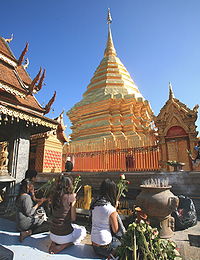 Buddhists making offerings at Wat Phrathat Doi Suthep
Buddhists making offerings at Wat Phrathat Doi Suthep Main article: Buddhist devotion
Main article: Buddhist devotion- Taking refuge in the Triple Gem
- Worship (pūjā) — see also: Abhisheka
- Offerings
- Prostration (panipāta • namas-kara)
- Chanting
- Mantra
- Om mani padme hum
- Namo Amituofo
- Nam Myōhō Renge Kyō
- Buddho
- Namo tassa bhagavato arahato sammāsambuddhassa — Homage to the Blessed One, the Worthy One, the Fully Self-enlightened One
- Mantra
Moral discipline and precepts (Sīla • Śīla)
Main article: Śīla- Five Precepts (pañca-sīlāni • pañca-śīlāni)
- Abstaining from taking life (pāṇātipātā veramaṇī)
- Abstaining from taking what is not given (adinnādānā veramaṇī)
- Abstaining from sexual misconduct (kāmesu micchācāra veramaṇī)
- Abstaining from false speech (musāvāda veramaṇī)
- Abstaining from drinks and drugs that cause heedlessness (surā-meraya-majja-pamādaṭṭhānā veramaṇī)
- Eight Precepts (aṭṭhasīla)
- Abstaining from taking life (both human and non-human)
- Abstaining from taking what is not given (stealing)
- Abstaining from all sexual activity
- Abstaining from telling lies
- Abstaining from using intoxicating drinks and drugs which lead to carelessness
- Abstaining from eating at the wrong time (the right time is eating once, after sunrise, before noon)
- Abstaining from singing, dancing, playing music, attending entertainment performances, wearing perfume, and using cosmetics and garlands (decorative accessories)
- Abstaining from luxurious places for sitting or sleeping
- Ten Precepts (dasasīla)
- Abstaining from killing living things
- Abstaining from stealing
- Abstaining from un-chastity (sensuality, sexuality, lust)
- Abstaining from lying
- Abstaining from taking intoxicants
- Abstaining from taking food at inappropriate times (after noon)
- Abstaining from singing, dancing, playing music or attending entertainment programs (performances)
- Abstaining from wearing perfume, cosmetics and garland (decorative accessories)
- Abstaining from sitting on high chairs and sleeping on luxurious, soft beds
- Abstaining from accepting money
- Sixteen Precepts
- Three Treasures
- Taking refuge in the Buddha
- Taking refuge in the Dharma
- Taking refuge in the Sangha
- Three Pure Precepts
- Not Creating Evil
- Practicing Good
- Actualizing Good For Others
- Ten Grave Precepts
- Affirm life; Do not kill
- Be giving; Do not steal
- Honor the body; Do not misuse sexuality
- Manifest truth; Do not lie
- Proceed clearly; Do not cloud the mind
- See the perfection; Do not speak of others errors and faults
- Realize self and other as one; Do not elevate the self and blame others
- Give generously; Do not be withholding
- Actualize harmony; Do not be angry
- Experience the intimacy of things; Do not defile the Three Treasures
- Three Treasures
- Vinaya
- Pātimokkha (Pratimoksha) — the code of monastic rules binding on members of the Buddhist monastic order
- Parajika (defeats) — four rules entailing expulsion from the sangha for life
- Sexual intercourse, that is, any voluntary sexual interaction between a bhikkhu and a living being, except for mouth-to-mouth intercourse which falls under the sanghadisesa
- Stealing, that is, the robbery of anything worth more than 1/24 troy ounce of gold (as determined by local law.)
- Intentionally bringing about the death of a human being, even if it is still an embryo — whether by killing the person, arranging for an assassin to kill the person, inciting the person to die, or describing the advantages of death
- Deliberately lying to another person that one has attained a superior human state, such as claiming to be an arahant when one knows one is not, or claiming to have attained one of the jhanas when one knows one hasn't
- Sanghadisesa — thirteen rules requiring an initial and subsequent meeting of the sangha (communal meetings)
- Aniyata — two indefinite rules where a monk is accused of having committed an offence with a woman in a screened (enclosed) or private place by a lay person
- Nissaggiya pacittiya — thirty rules entailing "confession with forfeiture"
- Pacittiya — ninety-two rules entailing confession
- Patidesaniya — four violations which must be verbally acknowledged
- Sekhiyavatta — seventy-five rules of training, which are mainly about the deportment of a monk
- Sāruppa — proper behavior
- Bhojanapatisamyutta — food
- Dhammadesanāpatisamyutta — teaching dhamma
- Pakinnaka — miscellaneous
- Adhikarana-samatha — seven rules for settlement of legal processes that concern monks only
- Parajika (defeats) — four rules entailing expulsion from the sangha for life
- Pātimokkha (Pratimoksha) — the code of monastic rules binding on members of the Buddhist monastic order
- Bodhisattva vows
- Samaya — a set of vows or precepts given to initiates of an esoteric Vajrayana Buddhist order
- Ascetic practices (dhutanga) — a group of thirteen austerities, or ascetic practices, most commonly observed by Forest Monastics of the Theravada Tradition of Buddhism
Three Resolutions
- To abstain from all evil (sabbapāpassa akaraṇaṃ)
- To cultivate the good (kusalassa upasampadā)
- To purify one's mind (sacittapariyodapanaṃ)
Three Pillars of Dhamma
- Generosity (dāna)
- Morality (sīla • śīla)
- Meditation (bhāvanā)
Threefold Training (Sikkhā)
Main article: Threefold Training- The training in the higher moral discipline (adhisīla-sikkhā) — morality (sīla • śīla)
- The training in the higher mind (adhicitta-sikkhā) — concentration (samādhi)
- The training in the higher wisdom (adhipaññā-sikkhā) — wisdom (paññā • prajñā)
Five Qualities
- Faith (saddhā • śraddhā)
- Morality (sīla • śīla)
- Learning (suta)
- Generosity (cāga)
- Wisdom (paññā • prajñā)
Five Powers of a Trainee
- Faith (saddhā • śraddhā)
- Conscience (hiri) — an innate sense of shame over moral transgression
- Concern (ottappa) — moral dread, fear of the results of wrongdoing
- Energy (viriya • vīrya)
- Wisdom (paññā • prajñā)
Five Things that lead to Awakening
- Admirable friendship (kalyāṇa-mittatā • kalyāṇa-mitratā)
- Morality (sīla • śīla)
- Hearing the Dhamma
- Exertion (viriya • vīrya)
- Awareness of impermanence (anicca-ñāṇa)
Five Subjects for Contemplation
Main article: Upajjhatthana Sutta- I am subject to ageing, I am not exempt from ageing
- I am subject to illness, I am not exempt from illness
- I am subject to death, I am not exempt from death
- There will be change and separation from all that I hold dear and near to me
- I am the owner of my actions, heir to my actions, I am born of my actions, I am related to my actions and I have my actions as refuge; whatever I do, good or evil, of that I will be the heir
Gradual training (Anupubbikathā)
Main articles: Gradual training and Anupubbikathā- Generosity (dāna)
- Virtue (sīla • śīla)
- Heaven (sagga)
- Danger of sensual pleasure (kāmānaṃ ādīnava)
- Renunciation (nekkhamma)
- The Four Noble Truths (cattāri ariyasaccāni • catvāri āryasatyāni)
Seven Good Qualities (Satta saddhammā)
- Faith (saddhā • śraddhā)
- Conscience (hiri)
- Moral dread (ottappa)
- Learning (suta)
- Energy (viriya • vīrya)
- Mindfulness (sati • smṛti)
- Wisdom (paññā • prajñā)
Ten Meritorious Deeds (Punnakiriya vatthu)
- Generosity (dāna)
- Morality (sīla • śīla)
- Meditation (bhāvanā)
- Paying due respect to those who are worthy of it (apacayana)
- Helping others perform good deeds (veyyavacca)
- Sharing of merit after doing some good deed (anumodana)
- Rejoicing in the merits of others (pattanumodana)
- Teaching the Dhamma (dhammadesana)
- Listening to the Dhamma (dhammassavana)
- Straightening one's own views
Perfections (Pāramī • Pāramitā)
Main article: PāramitāTen Theravada Pāramīs (Dasa pāramiyo)
- Generosity (dāna)
- Morality (sīla)
- Renunciation (nekkhamma)
- Wisdom (paññā)
- Energy (viriya)
- Patience (khanti)
- Truthfulness (sacca)
- Determination (adhiṭṭhāna)
- Loving-kindness (mettā)
- Equanimity (upekkhā)
Six Mahayana Pāramitās
- Generosity (dāna)
- Morality (śīla)
- Patience (kṣanti)
- Energy (vīrya)
- Concentration (dhyāna)
- Wisdom (prajñā)
States Pertaining to Enlightenment (Bodhipakkhiyādhammā • Bodhipakṣa dharma)
Main article: BodhipakkhiyādhammāFour Foundations of Mindfulness (Cattāro satipaṭṭhānā • Smṛtyupasthāna)
Main article: Satipatthana- Contemplation of the body (kāyagatāsati • kāyasmṛti)
- Mindfulness of breathing (ānāpānasati • ānāpānasmṛti)
- Contemplation of the body (kāyanupassana) — first tetrad
- Breathing a long breath
- Breathing a short breath
- Experiencing the whole (breath-) body (awareness of the beginning, middle, and end of the breath)
- Tranquilizing the bodily formation
- Contemplation of feelings (vedanānupassana) — second tetrad
- Experiencing rapture
- Experiencing bliss
- Experiencing the mental formation
- Tranquilizing the mental formation
- Contemplation of the mind (cittanupassana) — third tetrad
- Experiencing the mind
- Gladdening the mind
- Concentrating the mind
- Liberating the mind
- Contemplation of Dhammas (dhammānupassana) — fourth tetrad
- Contemplating impermanence (aniccānupassī)
- Contemplating fading away (virāgānupassī)
- Contemplating cessation (nirodhānupassī)
- Contemplating relinquishment (paṭinissaggānupassī)
- Contemplation of the body (kāyanupassana) — first tetrad
- Postures
- Clear comprehension (sampajañña • samprajaña)
- Clear comprehension of the purpose of one's action (sātthaka)
- Clear comprehension of the suitability of one's means to the achievement of one's purpose (sappāya)
- Clear comprehension of the domain, that is, not abandoning the subject of meditation during one's daily routine (gocara)
- Clear comprehension of reality, the awareness that behind one's activities there is no abiding self (asammoha)
- Reflections on repulsiveness of the body, meditation on the thirty-two body parts (patikulamanasikara)
- Reflections on the material elements (mahābhūta)
- Cemetery contemplations (asubha)
- Swollen or bloated corpse
- Corpse brownish black or purplish blue with decay
- Festering or suppurated corpse
- Corpse splattered half or fissured from decay
- Corpse gnawed by animals such as wild dogs and foxes
- Corpse scattered in parts, hands, legs, head and body being dispersed
- Corpse cut and thrown away in parts after killing
- Bleeding corpse, i.e. with red blood oozing out
- Corpse infested with and eaten by worms
- Remains of a corpse in a heap of bones, i.e. skeleton
- Mindfulness of breathing (ānāpānasati • ānāpānasmṛti)
- Contemplation of feelings (vedanāsati • vedanāsmṛti)
- Pleasant feeling
- Worldly pleasant feeling
- Spiritual pleasant feeling
- Painful feeling
- Worldly painful feeling
- Spiritual painful feeling
- Neither-pleasant-nor-painful (neutral) feeling
- Worldly neutral feeling
- Spiritual neutral feeling
- Pleasant feeling
- Contemplation of consciousness (cittasati • cittasmṛti)
- With lust (sarāgaṃ) or without lust (vītarāgaṃ)
- With hate (sadosaṃ) or without hate (vītadosaṃ)
- With delusion (samohaṃ) or without delusion (vītamohaṃ)
- Contracted (saṅkhittaṃ) or scattered (vikkhittaṃ)
- Lofty (mahaggataṃ) or not lofty (amahaggataṃ)
- Surpassable (sa-uttaraṃ) or unsurpassed (anuttaraṃ)
- Quieted (samāhitaṃ) or not quieted (asamāhitaṃ)
- Released (vimuttaṃ) or not released (avimuttaṃ)
- Contemplation of mental objects (dhammāsati • dharmasmṛti)
Four Right Exertions (Cattārimāni sammappadhānāni • Samyak-pradhāna)
Main article: Four Right Exertions- Exertion for the non-arising (anuppādāya) of unskillful states
- Exertion for the abandoning (pahānāya) of unskillful states
- Exertion for the arising (uppādāya) of skillful states
- Exertion for the sustaining (ṭhitiyā) of skillful states
Four Bases for Spiritual Power (Iddhipāda • Ṛddhipāda)
Main article: Iddhipada- Concentration due to desire (chanda)
- Concentration due to energy (viriya • vīrya)
- Concentration due to mind (citta)
- Concentration due to investigation (vīmaṃsā)
Five Spiritual Faculties (Pañca indriya)
Main article: Indriya- Faith (saddhā • śraddhā) — faith in the Buddha's awakening
- Energy (viriya • vīrya) — exertion towards the Four Right Efforts
- Mindfulness (sati • smṛti) — focusing on the four satipatthana
- Concentration (samādhi) — achieving the four jhānas
- Wisdom (paññā • prajñā) — discerning the Four Noble Truths
Five Strengths (Pañca bala)
Main article: Five Strengths- Faith (saddhā • śraddhā) — controls doubt
- Energy (viriya • vīrya) — controls laziness
- Mindfulness (sati • smṛti) — controls heedlessness
- Concentration (samādhi) — controls distraction
- Wisdom (paññā • prajñā) — controls ignorance
Seven Factors of Enlightenment (Satta sambojjhaṅgā • Sapta bodhyanga)
Main article: Seven Factors of EnlightenmentNeutral
- Mindfulness (sati • smṛti)
Arousing
- Investigation of doctrine (dhamma vicaya • dharma-vicaya)
- Energy (viriya • vīrya)
- Rapture (pīti • prīti)
Calming
- Tranquillity (passaddhi)
- Concentration (samādhi)
- Equanimity (upekkhā • upekṣā)
Noble Eightfold Path (Ariyo aṭṭhaṅgiko maggo • Ārya 'ṣṭāṅga mārgaḥ)
Main article: Noble Eightfold PathWisdom (Paññākkhandha)
- Right view (sammā-diṭṭhi • samyag-dṛṣṭi)
- Mundane right view
- Supramundane right view
- Right view that accords with the Four Noble Truths (saccanulomika sammā-diṭṭhi)
- Study
- Reflection
- Meditation
- Right view that penetrates the Four Noble Truths (saccapativedha sammā-diṭṭhi)
- Right view that accords with the Four Noble Truths (saccanulomika sammā-diṭṭhi)
- Right intention (sammā-saṅkappa • samyak-saṃkalpa)
- The intention of renunciation (nekkhamma-sankappa)
- The intention of good will (abyapada-sankappa)
- The intention of harmlessness (avihimsa-sankappa)
Moral discipline (Sīlakkhandha)
- Right speech (sammā-vācā • samyag-vāc)
- Abstaining from false speech (musāvāda veramaṇī)
- Abstaining from slanderous speech (pisunaya vacaya veramaṇī)
- Abstaining from harsh speech (pharusaya vacaya veramaṇī)
- Abstaining from verbal abuse
- Abstaining from insults
- Abstaining from sarcasm
- Abstaining from idle chatter (samphappalāpa veramaṇī)
- Right action (sammā-kammanta • samyak-karmānta)
- Abstaining from the taking of life (pāṇātipātā veramaṇī)
- Abstaining from homicide
- Abstaining from animal slaughter
- Abstaining from deliberately harming or torturing another being
- Abstaining from taking what is not given (adinnādānā veramaṇī)
- Abstaining from stealing
- Abstaining from robbery
- Abstaining from snatching
- Abstaining from fraudulence
- Abstaining from deceitfulness
- Abstaining from sexual misconduct (kāmesu micchācāra veramaṇī)
- Abstaining from adultery
- Abstaining from sexual harassment
- Abstaining from rape
- Abstaining from the taking of life (pāṇātipātā veramaṇī)
- Right livelihood (sammā-ājīva • samyag-ājīva)
- Abstaining from dealing in weapons
- Abstaining from dealing in living beings (including raising animals for slaughter as well as slave trade and prostitution)
- Abstaining from dealing in meat production and butchery
- Abstaining from dealing in poisons
- Abstaining from dealing in intoxicants
- Abstaining from deceit
- Abstaining from treachery
- Abstaining from soothsaying
- Abstaining from trickery
- Abstaining from usury
Concentration (Samādhikkhandha)
- Right effort (sammā-vāyāma • samyag-vyāyāma)
- The effort to prevent the arising of unarisen unwholesome states (samvarappadhana)
- Wise attention (yoniso manasikara)
- Restraint of the sense faculties (indriya-samvara)
- The effort to abandon unwholesome states that have already arisen (pahanappadhana)
- Overcoming the Five hindrances
- The effort to arouse wholesome states that have not yet arisen (bhavanappadhana)
- Seven Factors of Enlightenment (satta sambojjhaṅgā • sapta bodhyanga)
- Mindfulness (sati)
- Investigation of doctrine (dhamma vicaya)
- Energy (viriya • vīrya)
- Rapture (pīti)
- Tranquillity (passaddhi)
- Concentration (samādhi)
- Equanimity (upekkha)
- Seven Factors of Enlightenment (satta sambojjhaṅgā • sapta bodhyanga)
- The effort to maintain and perfect wholesome states already arisen (anurakkhanappadhana)
- The effort to prevent the arising of unarisen unwholesome states (samvarappadhana)
- Right mindfulness (sammā-sati • samyak-smṛti)
- Contemplation of the body (kāyanupassana)
- Contemplation of feeling (vedanānupassana)
- Contemplation of states of mind (cittanupassana)
- Contemplation of phenomena (dhammānupassana)
- Right concentration (sammā-samādhi • samyak-samādhi)
- Four jhānas
- First jhāna (pathamajjhana)
- Second jhāna (dutiyajjhana)
- Third jhāna (tatiyajjhana)
- Fourth jhāna (catutthajjhana)
- Four jhānas
Acquired factors
- Right knowledge (sammā-ñāṇa)
- Right liberation (sammā-vimutti)
Buddhist meditation
Main articles: Buddhist meditation and BhavanaTheravada meditation practices
Serenity (Samatha • Śamatha)
Main article: Samatha- Place of work (kammaṭṭhāna)
- Ten Kasinas
- Earth kasina (pathavikasinam)
- Water kasina (apokasinam)
- Fire kasina (tejokasinam)
- Wind kasina (vayokasinam)
- Brownish or deep purplish blue kasina (nilakasinam)
- Yellow kasina (pitakasinam)
- Red kasina (lohitakasinam)
- White kasina (odatakasinam)
- Light kasina (alokakasinam)
- Open air-space, sky kasina (akasakasinam)
- Ten reflections on repulsiveness (asubas)
- A swollen or bloated corpse (uddhumatakam)
- A corpse brownish black or purplish blue with decay (vinilakam)
- A festering or suppurated corpse (vipubbakam)
- A corpse splattered half or fissured from decay (vicchiddakam)
- A corpse gnawed by animals such as wild dogs and foxes (vikkhayittakam)
- A corpse scattered in parts, hands, legs, head and body being dispersed (vikkhitakam)
- A corpse cut and thrown away in parts after killing (hatavikkhittakam)
- A bleeding corpse, i.e. with red blood oozing out (lohitakam)
- A corpse infested with and eaten by worms (puluvakam)
- Remains of a corpse in a heap of bones, i.e. skeleton (atthikam)
- Ten Recollections (anussati • anusmriti)
- Buddhānussati (Buddhanusmrti) — Recollection of the Buddha — fixing the mind with attentiveness and reflecting repeatedly on the glorious virtues and attributes of Buddha
- Dhammānussati (Dharmanusmrti) — Recollection of the Dhamma — reflecting with serious attentiveness repeatedly on the virtues and qualities of Buddha's teachings and his doctrine
- Saṅghānussati (Sanghanusmrti) — Recollection of the Saṅgha — fixing the mind strongly and repeatedly upon the rare attributes and sanctity of the Sangha
- Sīlānussati — Recollection of virtue — reflecting seriously and repeatedly on the purification of one's own morality or sīla
- Cāgānussati — Recollection of generosity — reflecting repeatedly on the mind's purity in the noble act of one's own dāna, charitableness and liberality
- Devatānussati — Recollection of deities — reflecting with serious and repeated attention on one's own complete possession of the qualities of absolute faith (saddhā), morality (sīla), learning (suta), liberality (cāga) and wisdom (paññā) just as the devas have, to enable one to be reborn in the world of devas
- Maraṇānussati — Mindfulness of death — reflecting repeatedly on the inevitability of death
- Kāyagatāsati — Mindfulness of the body — reflecting earnestly and repeatedly on the impurity of the body which is composed of the detestable 32 constituents such as hair, body hair, nails, teeth, skin, etc.
- Ānāpānasati — Mindfulness of breathing — repeated reflection on the inhaled and exhaled breath
- Upasamānussati — Recollection of peace — reflecting repeatedly with serious attentiveness on the supreme spiritual blissful state of Nirvana
- Four Divine Abidings (brahmavihāra)
- Loving-kindness (mettā • maitrī)
- Compassion (karuṇā)
- Sympathetic joy (muditā)
- Equanimity (upekkhā • upekṣā)
- Four formless jhānas (arūpajhāna)
- Base of the infinity of space (ākāsānañcāyatana)
- Base of the infinity of consciousness (viññāṇañcāyatana)
- Base of nothingness (ākiñcaññāyatana)
- Base of neither-perception-nor-nonperception (nevasaññānāsaññāyatana)
- Perception of disgust of food (aharepatikulasanna)
- Four Great Elements (mahābhūta)
- Earth element (paṭhavī-dhātu)
- Water (or liquid) element (āpo-dhātu)
- Fire element (tejo-dhātu)
- Air (or wind) element (vāyo-dhātu)
- Ten Kasinas
Concentration (Samādhi)
Main article: Samadhi (Buddhism)- Sign (nimitta)
- Learning sign (uggahanimitta)
- Counterpart sign (paṭibhāganimitta)
- Momentary concentration (khaṇikasamādhi)
- Preliminary concentration (parikammasamādhi)
- Neighbourhood concentration (upacārasamādhi)
- Nine attainments (samāpatti)
- Attainment concentration (appanāsamādhi)
- Jhāna (Dhyāna) — states of deep meditative concentration marked by the one-pointed fixation of the mind upon its object
- Four form jhānas (rūpajhāna)
- First jhāna (pathamajjhana)
- applied thought (vittaka)
- sustained thought (vicāra)
- rapture (pīti)
- bliss (sukha)
- one-pointedness (ekaggata)
- Second jhāna (dutiyajjhana)
- rapture (pīti)
- bliss (sukha)
- one-pointedness (ekaggata)
- Third jhāna (tatiyajjhana)
- bliss (sukha)
- one-pointedness (ekaggata)
- Fourth jhāna (catutthajjhana)
- one-pointedness (ekaggata)
- equanimity (upekkhā • upekṣā)
- First jhāna (pathamajjhana)
- Four formless jhānas (arūpajhāna)
- Base of the infinity of space (ākāsānañcāyatana)
- Base of the infinity of consciousness (viññāṇañcāyatana)
- Base of nothingness (ākiñcaññāyatana)
- Base of neither-perception-nor-nonperception (nevasaññānāsaññāyatana)
- Four form jhānas (rūpajhāna)
- Jhāna (Dhyāna) — states of deep meditative concentration marked by the one-pointed fixation of the mind upon its object
- Cessation of perception and feeling (nirodha-samāpatti)
- Attainment concentration (appanāsamādhi)
Insight meditation (Vipassanā • Vipaśyanā)
Main article: Vipassanā- Insight knowledge (vipassanā-ñāṇa)
- Vipassana jhanas
- Eighteen kinds of insight
- Contemplation on impermanence (aniccanupassana) overcomes the wrong idea of permanence
- Contemplation on unsatisfactoriness (dukkhanupassana) overcomes the wrong idea of real happiness
- Contemplation on non-self (anattanupassana) overcomes the wrong idea of self
- Contemplation on turning away (nibbidanupassana) overcomes affection
- Contemplation on detachment (viraganupassana) overcomes greed
- Contemplation on cessation (nirodhanupassana) overcomes the arising
- Contemplation on giving up (patinissagganupassana) overcomes attachment
- Contemplation on dissolution (khayanupassana) overcomes the wrong idea of something compact
- Contemplation on disappearance (vayanupassana) overcomes kamma-accumulation
- Contemplation on changeablenes (viparinamanupassana) overcomes the wrong idea of something immutable
- Contemplation on the signless (animittanupassana) overcomes the conditions of rebirth
- Contemplation on the desireless (appanihitanupassana) overcomes longing
- Contemplation on emptiness (suññatanupassana) overcomes clinging
- Higher wisdom and insight (adhipaññadhamma vipassana) overcomes the wrong idea of something substantial
- True eye of knowledge (yathabhuta ñanadassana) overcomes clinging to delusion
- Contemplation on misery (adinavanupassana) overcomes clinging to desire
- Reflecting contemplation (patisankhanupassana) overcomes thoughtlessness
- Contemplation on the standstill of existence (vivattanupassana) overcomes being entangled in fetters
- Sixteen Stages of Vipassanā Knowledge
- Knowledge to distinguish mental and physical states (namarupa pariccheda ñāṇa)
- Knowledge of the cause-and-effect relationship between mental and physical states (paccaya pariggaha ñāṇa)
- Knowledge of mental and physical processes as impermanent, unsatisfactory and nonself (sammasana ñāṇa)
- Knowledge of arising and passing away (udayabbaya ñāṇa)
- Knowledge of the dissolution of formations (bhanga ñāṇa)
- Knowledge of the fearful nature of mental and physical states (bhaya ñāṇa)
- Knowledge of mental and physical states as unsatisfactory (adinava ñāṇa)
- Knowledge of disenchantment (nibbida ñāṇa)
- Knowledge of the desire to abandon the worldly state (muncitukamayata ñāṇa)
- Knowledge which investigates the path to deliverance and instills a decision to practice further (patisankha ñāṇa)
- Knowledge which regards mental and physical states with equanimity (sankharupekha ñāṇa)
- Knowledge which conforms to the Four Noble Truths (anuloma ñāṇa)
- Knowledge of deliverance from the worldly condition (gotrabhu ñāṇa)
- Knowledge by which defilements are abandoned and are overcome by destruction (magga ñāṇa)
- Knowledge which realizes the fruit of the path and has nibbana as object (phala ñāṇa)
- Knowledge which reviews the defilements still remaining (paccavekkhana ñāṇa)
Zen meditation practices
- Zazen
- Concentration
- Kōan — a story, dialogue, question, or statement in Zen, containing aspects that are inaccessible to rational understanding, yet may be accessible to intuition
- Shikantaza — just sitting
Vajrayana meditation practices
- Tonglen
- Tantra
- Margaphala
- Ngöndro — Four thoughts which turn the mind towards Dharma
- The freedoms and advantages of precious human rebirth
- The truth of impermanence and change[disambiguation needed
 ]
] - The workings of karma
- The suffering of living beings within Samsara
Other practices
- Ahimsa — Non-violence
- Appamada — Heedfulness
- Chöd — advanced spiritual practice and discipline arising from confluences of Bonpo, Mahasidda, Nyingmapa traditions and now practiced throughout the schools of Tibetan Buddhism
- Merit
- Paritta — Protection
- Samvega and pasada
- Simran
Attainment of Enlightenment
Main article: Enlightenment in BuddhismGeneral
- Nirvana (Nibbāna • Nirvāṇa) — the final goal of the Buddha's teaching; the unconditioned state beyond the round of rebirths, to be attained by the destruction of the defilements; Full Enlightenment or Awakening, the complete cessation of suffering
- Parinirvana (Parinibbāna • Parinirvāṇa) — final passing away of an enlightened person
- Bodhi — the awakening experience attained by the Buddha and his accomplished disciples referring to the unique consciousness of a fully liberated yogi
- Types of Buddha
- Sammāsambuddha (Samyak-saṃbuddha) — one who, by his own efforts, attains Nirvana, having rediscovered the Noble Eightfold Path after it has been lost to humanity, and makes this Path known to others
- Paccekabuddha (Pratyekabuddha) — "a lone Buddha", a self-awakened Buddha, but one who lacks the ability to spread the Dhamma to others
- Sāvakabuddha (Śrāvakabuddha) — enlightened 'disciple of a Buddha'
Theravada
- Four stages of enlightenment (see also: Ariya-puggala — Noble Ones)
- Sotāpanna — Stream-enterer (first stage of enlightenment) — one who has "opened the eye of the Dhamma", and is guaranteed enlightenment after no more than seven successive rebirths, having eradicated the first three fetters
- The four factors leading to stream-entry
- Association with superior persons
- Hearing the true Dhamma
- Careful attention
- Practice in accordance with the Dhamma
- The four factors of a stream-enterer
- Possessing confirmed confidence in the Buddha
- Possessing confirmed confidence in the Dhamma
- Possessing confirmed confidence in the Sangha
- Possessing moral virtues dear to the noble ones
- The four factors leading to stream-entry
- Sakadagami — Once-returner (second stage of enlightenment) — will be reborn into the human world once more, before attaining enlightenment, having eradicated the first three fetters and attenuated greed, hatred, and delusion
- Anāgāmi — Non-returner (third stage of enlightenment) — does not come back into human existence, or any lower world, after death, but is reborn in the "Pure Abodes", where he will attain Nirvāṇa, having eradicated the first five fetters
- Arahant — "Worthy One", (see also: Arhat), a fully enlightened human being who has abandoned all ten fetters, and who upon decease (Parinibbāna) will not be reborn in any world, having wholly abandoned saṃsāra
- Sotāpanna — Stream-enterer (first stage of enlightenment) — one who has "opened the eye of the Dhamma", and is guaranteed enlightenment after no more than seven successive rebirths, having eradicated the first three fetters
Mahayana
- Bodhisattva — one who has generated bodhicitta, the spontaneous wish to attain Buddhahood
- Bodhisattva Bhumis — stages of enlightenment through which a bodhisattva passes
Zen
- Satori — a Japanese Buddhist term for "enlightenment", which translates as a flash of sudden awareness, or individual enlightenment
- Kensho — "Seeing one's nature"
Buddhist monasticism and laity
Main article: Buddhist monasticism- Disciple (sāvaka • śrāvaka)
- Male lay follower (upāsaka) and Female lay follower (upāsikā)
- Householder
- Dhammacārī — lay devotees who have seriously committed themselves to Buddhist practice for several years
- Anāgārika — lay attendant of a monk
- Jisha — personal attendant of a monastery's abbot or teacher in Zen Buddhism
- Ngagpa — non-monastic male practitioners of such disciplines as Vajrayana, shamanism, Tibetan medicine, Tantra and Dzogchen
- Thilashin — Burmese Buddhist female lay renunciant
- Mae ji — Buddhist laywomen in Thailand occupying a position somewhere between that of an ordinary lay follower and an ordained monk
- Lower ordination (pabbajja • pravrajya)
- Novice monk (sāmaṇera • śrāmaṇera)
- Novice nun (samaṇerī • śrāmaṇerī)
- Higher ordination (upasampadā)
- Titles for Buddhist teachers
- General
- in Theravada
- in Southeast Asia
- Ayya — commonly used as a veneration in addressing or referring to an ordained Buddhist nun
- in Thailand
- in Burma
- Sayādaw — a Burmese senior monk of a monastery
- in Southeast Asia
- in Japan
- in Zen
- in Japan
- Kaisan — founder of a school of Buddhism or the founding abbot of a Zen monastery
- Roshi — a Japanese honorific title used in Zen Buddhism that literally means "old teacher" or "elder master" and usually denotes the person who gives spiritual guidance to a Zen sangha
- Sensei — ordained teacher below the rank of roshi
- Zen master — individual who teaches Zen Buddhism to others
- in Korea
- Sunim — Korean title for a Buddhist monk or Buddhist nun
- in Japan
- in Tibetan Buddhism
- Geshe — Tibetan Buddhist academic degree for monks
- Guru
- Khenpo — academic degree similar to that of a doctorate or Geshe. Khenpo's often are made abbots of centers and monasteries
- Khenchen — academic degree similar in depth to post doctorate work. Senior most scholars often manage many Khenpos
- Lama — Tibetan teacher of the Dharma
- Rinpoche — an honorific which literally means "precious one"
- Tulku — an enlightened Tibetan Buddhist lama who has, through phowa and siddhi, consciously determined to take birth, often many times, in order to continue his or her Bodhisattva vow
Major figures of Buddhism
Main article: List of BuddhistsFounder
- Gautama Buddha — The Buddha, Siddhattha Gotama (Pali), Siddhārtha Gautama (Sanskrit), Śākyamuni (Sage of the Sakya clan), The Awakened One, The Enlightened One, The Blessed One, Tathāgata (Thus Come One, Thus Gone One)
Buddha's disciples and early Buddhists
Chief Disciples
- Sāriputta — Chief disciple, "General of the Dhamma", foremost in wisdom
- Mahamoggallāna — Second chief disciple, foremost in psychic powers
Great Disciples
Monks
 Ānanda reciting the Suttapitaka at the First Buddhist Council
Ānanda reciting the Suttapitaka at the First Buddhist Council
- Ānanda — Buddha's cousin and personal attendant
- Maha Kassapa — Convener of First Buddhist Council
- Anuruddha — Half-cousin of the Buddha
- Mahakaccana — Foremost in teaching
- Nanda — Half-brother of the Buddha
- Subhuti
- Punna
- Upali — Master of the Vinaya
Nuns
- Mahapajapati Gotami — Eldest nun
- Khema — First great female disciple in power
- Uppalavanna — Second great female disciple
Laymen
- Anathapindika — Chief lay disciple, foremost disciple in generosity
- Hatthaka of Alavi
- Jivaka
- Citta — the foremost householder for explaining the Teaching
- Cunda
Laywomen
First five disciples of the Buddha
- Kondañña — the first Arahant
- Assaji — converted Sāriputta and Mahamoggallāna
- Bhaddiya
- Vappa
- Mahanama
Two seven-year-old Arahants
- Samanera Sumana
- Samanera Pandita
Other disciples
- Channa — royal servant and head charioteer of Prince Siddhartha
- Angulimala — mass murderer turned saint
- Kisa Gotami
Later Indian Buddhists (after Buddha)
- Buddhaghosa — 5th-century Indian Theravadin Buddhist commentator and scholar, author of the Visuddhimagga
- Mahinda — son of Emperor Ashoka
- Sanghamitta — daughter of Emperor Ashoka
- Nagarjuna — founder of the Madhyamaka school
- Aryadeva — disciple of Nagarjuna
- Asanga — exponent of the yogācāra school
- Vasubandhu
- Buddhapālita — commentator on the works of Nagarjuna and Aryadeva
- Candrakīrti
- Dharmakirti
- Atisha
Indo-Greek Buddhists
Chinese Buddhists
Tibetan Buddhists
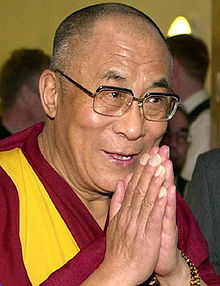 The 14th Dalai Lama, a renowned Tibetan Buddhist monk.
The 14th Dalai Lama, a renowned Tibetan Buddhist monk.
- Je Tsongkhapa
- Milarepa
- Longchenpa
- Marpa Lotsawa
- Padmasambhava
- Sakya Pandita
- Panchen Lama
- Karmapa
- Dalai Lama
- 1st Dalai Lama
- 2nd Dalai Lama
- 3rd Dalai Lama
- 4th Dalai Lama
- 5th Dalai Lama
- 6th Dalai Lama
- 7th Dalai Lama
- 8th Dalai Lama
- 9th Dalai Lama
- 10th Dalai Lama
- 11th Dalai Lama
- 12th Dalai Lama
- 13th Dalai Lama
- 14th Dalai Lama
Japanese Buddhists
Vietnamese Buddhists
- Thích Nhất Hạnh
- Thich Chan Khong
- Thich Thiên Ân
- Thich Quang Duc
Burmese Buddhists
- Ledi Sayadaw
- Mahāsī Sayādaw
- Webu Sayadaw
- U Ba Khin
- Mother Sayamagyi
- U Pandita
- S. N. Goenka
Thai Buddhists
- Ajahn Buddhadasa
- Ajahn Chah
- Ajahn Maha Bua
- Ajahn Mun Bhuridatta
- Ajahn Thate
Sri Lankan Buddhists
- Balangoda Ananda Maitreya
- Henepola Gunaratana
- K. Sri Dhammananda
- Piyadassi Maha Thera
- Walpola Rahula
American Buddhists
Brazilian Buddhists
- Lama Padma Samten
- Coen Sensei
British Buddhists
German Buddhists
Irish Buddhists
- U Dhammaloka
Buddhist philosophy
Main article: Buddhist philosophyGolden statue of Nagarjuna at Samye Ling Monastery.
- Abhidharma (Abhidhamma)
- Buddhist anarchism
- Buddhist atomism
- Buddhism and the body
- Buddhology
- Engaged Buddhism
- Buddhist economics
- Buddhist eschatology
- Buddhist ethics
- Buddhism and abortion
- Buddhism and euthanasia
- Sexuality and Buddhism
- Buddhist views on masturbation
- LGBT topics and Buddhism
- Buddhism and evolution
- Fourteen unanswerable questions
- Questions referring to the world: concerning the existence of the world in time
- Is the world eternal?
- or not?
- or both?
- or neither?
- Questions referring to the world: concerning the existence of the world in space
- Is the world finite?
- or not?
- or both?
- or neither?
- Questions referring to personal experience
- Questions referring to life after death
- Questions referring to the world: concerning the existence of the world in time
- God in Buddhism
- Humanistic Buddhism
- Buddhist logic
- Buddhist mythology
- Reality in Buddhism
- Buddhist socialism
Buddhist culture
Main articles: Buddhist culture and art and Cultural elements of BuddhismImitation currency burned for ancestors, during the Ghost Festival Tibetan monks creating a sand mandala.
Tibetan monks creating a sand mandala.
- Alms
- Ango — three month long period of intense training for students of Zen Buddhism
- Buddhist architecture
- Vihara — Buddhist monastery
- Wat — monastery temple in Cambodia, Thailand, Lanna or Laos
- Thai temple art and architecture
- Stupa — mound-like structure containing Buddhist relics
- Pagoda — tiered tower with multiple eaves common in China, Japan, Korea, Vietnam, and other parts of Asia
- Zendo — meditation hall in Zen Buddhism
- Butsudan — shrine
- Buddhist art
- Greco-Buddhist art
- Buddhist poetry
- Buddhist music
- Buddha statue
- Buddhist calendar
- Buddhist clothes
- Tricivara — Monastic robe
- Antaravasaka — Lower robe
- Uttarasanga — Upper robe
- Sangati — Outer robe
- Tricivara — Monastic robe
- Buddhist cuisine
- Dharani
- Drubchen — traditional form of meditation retreat in Tibetan Buddhism
- Funeral (Buddhism)
- Buddhist holidays
- Vesak — birth, enlightenment (Nirvana), and passing away (Parinirvana) of Gautama Buddha
- Asalha Puja
- Magha Puja
- Uposatha — the Buddhist observance days, falling on the days of the full moon and new moon, when the monks gather to recite the Pātimokkha and lay people often visit monasteries and temples to undertake the eight precepts
- Kathina — festival which comes at the end of Vassa
- Kaicho
- Kīla — three-sided peg, stake, knife, or nail like ritual implement traditionally associated with Indo-Tibetan Buddhism
- Mandala — concentric diagram having spiritual and ritual significance
- Buddhist prayer beads — Mala
- Mantra
- Om mani padme hum
- Namo Amituofo
- Nam Myōhō Renge Kyō
- Om tare tuttare ture svaha
- Buddho
- Namo Tassa Bhagavato Arahato Sammāsambuddhassa
- Buddhist view of marriage
- Mudra — Symbolic or ritual gesture
- Añjali Mudrā — greeting gesture which consists of putting the palms together in front of the chest
- Buddhist music
- Prayer wheel
- Sarira — Buddhist relics
- Sesshin — period of intensive meditation (zazen) in a Zen monastery
- Buddhist symbolism
- Dharmacakra — Wheel of Dhamma
- Bhavacakra — Wheel of Becoming
- Buddhist flag
- Ensō — Symbol in Zen symbolizing enlightenment, strength, elegance, the Universe, and the void
- Thangka
- Ashtamangala
- Vajra — short metal weapon that has the symbolic nature of a diamond
- Vassa — Rains retreat
Buddhist pilgrimage
Main article: Buddhist pilgrimage- The Four Main Sites
- Lumbini — Buddha's birthplace
- Bodh Gaya — Buddha's place of Enlightenment
- Sarnath — Place of Buddha's first discourse
- Kushinagar — Place of Buddha's final passing away
- Four Additional Sites
- Other Sites
- Later Sites
Comparative Buddhism
- Buddhism and science
- Buddhism and Theosophy
- Buddhism and other religions
- Buddhism and Eastern religions
- Buddhism and Christianity
- Buddhist-Christian Studies
- Parallels between Buddha and Jesus
- Buddhism and Gnosticism
- Gautama Buddha in world religions
Main article: Index of Buddhism-related articles- Access to Insight — Readings in Theravada Buddhism website
- Anuradhapura
- Mahavihara
- Abhayagiri Vihara
- Asceticism
- Ashoka the Great
- Basic Points Unifying the Theravāda and the Mahāyāna
- The Buddha is our only Master (teacher and guide)
- We take refuge in the Buddha, the Dharma and the Saṅgha (the Three Jewels)
- We do not believe that this world is created and ruled by a God.
- We consider that the purpose of life is to develop compassion for all living beings without discrimination and to work for their good, happiness, and peace; and to develop wisdom (prajñā) leading to the realization of Ultimate Truth
- We accept the Four Noble Truths, namely duḥkha, the arising of duḥkha, the cessation of duḥkha, and the path leading to the cessation of duḥkha; and the law of cause and effect (pratītyasamutpāda)
- All conditioned things (saṃskāra) are impermanent (anitya) and duḥkha, and that all conditioned and unconditioned things (dharma) are without self (anātma) (see trilaksana).
- We accept the thirty-seven qualities conducive to enlightenment (bodhipakṣadharma) as different aspects of the Path taught by the Buddha leading to Enlightenment.
- There are three ways of attaining bodhi or Enlightenment: namely as a disciple (śrāvaka), as a pratyekabuddha and as a samyaksambuddha (perfectly and fully enlightened Buddha). We accept it as the highest, noblest, and most heroic to follow the career of a Bodhisattva and to become a samyaksambuddha in order to save others.
- We admit that in different countries there are differences regarding Buddhist beliefs and practices. These external forms and expressions should not be confused with the essential teachings of the Buddha.
- Black Buddhist
- Bodhimanda (Bodhimandala)
- Bodhisatta — a future Buddha, one destined to attain unsurpassed perfect enlightenment; specifically, it is the term the Buddha uses to refer to himself in the period prior to his enlightenment, both in past lives and in his last life before he attained enlightenment
- Bodhisattvas
- Akasagarbha
- Avalokiteśvara (Guan Yin)
- Guan Yu
- Ksitigarbha
- Mahasthamaprapta
- Maitreya — Future Buddha, successor of Gautama Buddha
- Manjusri — the bodhisattva associated with wisdom, doctrine and awareness
- Nio
- Samantabhadra
- Shantideva
- Sitatapatra
- Skanda
- Supushpachandra
- Suryaprabha
- Tara
- Vajrapani
- Vasudhara
- Borobudur — ninth-century Mahayana Buddhist Monument in Magelang, Indonesia
- Brahmā — according to the brahmins, the supreme personal deity, but in the Buddha's teaching, a powerful deity who rules over a high divine state of existence called the brahma world; more generally, the word denotes the class of superior devas inhabiting the form realm
- Brahmacariya — the Holy Life
- Budai or Hotei — the obese Laughing Buddha, usually seen in China
- Buddhas
- Gautama Buddha
- Dipankara Buddha
- Kakusandha Buddha
- Kassapa Buddha
- Padumuttara Buddha
- Adi-Buddha
- Amitābha — the principal Buddha in the Pure Land sect
- Medicine Buddha
- Buddhas of Bamyan
- Buddhavacana — the Word of the Buddha
- Buddhist calendar
- Buddhist Initiation Ritual — a public ordination ceremony wherein a lay student of Zen Buddhism receives certain Buddhist precepts, "a rite in which they publicly avow allegiance to 'The Three Refuges' of Buddhist practice: The Buddha, the Dharma and the Sangha
- Buddhist Publication Society — a charity whose goal is to explain and spread the doctrine of the Buddha
- Buddhist Studies
- Cambridge Buddhist Association
- Chakravartin — Wheel-turning Monarch
- Critical Buddhism
- Dalit Buddhist movement
- Deva — a deity or god; the beings inhabiting the heavenly worlds, usually in the sense-sphere realm but more broadly in all three realms
- Dhammakaya[disambiguation needed
 ]
]
- Dharma name
- Dharma talk
- Dharma transmission
- Diamond Way Buddhism
- Dipavamsa
- Eight Thoughts of a Great Man
- This Dhamma is for one who wants little, not for one who wants much.
- This Dhamma is for the contented, not for the discontented.
- This Dhamma is for the secluded, not for one fond of society.
- This Dhamma is for the energetic, not for the lazy.
- This Dhamma is for the mindful, not for the unmindful.
- This Dhamma is for the composed, not for the uncomposed.
- This Dhamma is for the wise, not for the unwise.
- This Dhamma is for one who is free from impediments, not for one who delights in impediments
- Empowerment
- European Buddhist Union
- Five Dhyani Buddhas
- Five Pure Lights
- Foundation for the Preservation of the Mahayana Tradition
- Friends of the Western Buddhist Order
- Gandhabba
- Gandhāran Buddhist Texts
- Glossary of Japanese Buddhism
- Hinayana — "Inferior vehicle", often interpreted as a pejorative term used in Mahayana doctrine to refer to the early Buddhist schools
- HUMUH: Transcendental Buddhism
- Icchantika
- Inka
- International Buddhist College
- Jambudvipa — lit., "rose-apple island," the Indian subcontinent
- Jetavana
- Kalachakra
- Kalpa (aeon) — an aeon or cosmic cycle, the period of time it takes for a world system to arise, evolve, dissolve, and persist in a state of disintegration before a new cycle begins
- Kanthaka — Prince Siddhartha's favourite white horse
- Kegon
- King Ajatasattu
- King Bimbisara
- King Milinda
- King Pasenadi
- Kosala
- Kwan Um School of Zen
- Laughing Buddha
- Lineage
- Liturgical languages
- Luang Prabang
- Mahasati meditation
- Mahavamsa
- Māra — "The Evil One" or "Tempter"; a malevolent deity who tries to prevent people from practicing the Dhamma and thereby escaping the round of rebirths
- Klesa-māra, or Māra as the embodiment of all unskillful emotions
- Mrtyu-māra, or Māra as death, in the sense of the ceaseless round of birth and death
- Skandha-māra, or Māra as metaphor for the entirety of conditioned existence
- Devaputra-māra, or Māra the son of a deva (god), that is, Māra as an objectively existent being rather than as a metaphor
- Medicine Buddha
- Monasteries
- Nāga — the Serpent King
- Nikāya
- Nikaya Buddhism
- Noble Silence
- Pali Text Society
- Perfection of Wisdom School
- Persecution of Buddhists
- Phra Pathom Chedi
- Purity in Buddhism
- Ramifications of the Buddha concept
- Releasing life
- Saddhamma — True Dhamma
- Sakka — the King of gods
- Samaṇa
- Samāpatti — correct acquisition of Truth
- Sāsana — Dispensation
- Shakya — ancient kingdom of Iron Age India, Siddhartha Gautama's clan
- Shambhala Buddhism
- Southern, Eastern and Northern Buddhism
- Sumeru — central world-mountain in Buddhist cosmology
- Sutra
- The birth of Buddha (Lalitavistara)
- The Path to Nirvana
- Three Ages of Buddhism
- Three Turnings of the Wheel of Dharma
- True Buddha School
- Two foremost teachers (two persons which one can never pay back gratitude-debts in full)
- Vipassana movement
- Women in Buddhism
- World Buddhist Sangha Council
- World Fellowship of Buddhists
- Yakkha — a broad class of nature-spirits, usually benevolent, who are caretakers of the natural treasures hidden in the earth and tree roots
- Yama — King of Death
- Yana — Vehicle
- Śrāvakayāna — the hearer vehicle
- Pratyekayana — the individual vehicle
- Bodhisattvayāna
- Young Buddhist Association
- Young Men's Buddhist Association
- Zabuton — rectangular meditation cushion
- Zafu — round meditation cushion
Lists
- Glossary of Buddhism
- Index of Buddhism-related articles
- List of Buddhas
- List of Buddha claimants
- List of bodhisattvas
- List of Buddhists
- List of modern scholars in Buddhist studies
- List of suttas
- in Theravada
- List of Digha Nikaya suttas
- List of Majjhima Nikaya suttas
- List of Samyutta Nikaya suttas
- List of Anguttara Nikaya suttas
- List of Khuddaka Nikaya suttas
- in Mahayana
- in Theravada
- List of books related to Buddhism
- List of Buddhist temples
- Buddhist temples in Japan
- Korean Buddhist temples
- List of Buddhist Architecture in China
- List of Buddhist temples in Thailand
- List of Buddhist writers
- Buddha games list
See also
References
- ^ Cousins, L.S. (1996); Buswell (2003), Vol. I, p. 82; and, Keown & Prebish (2004), p. 107. See also, Gombrich (1988/2002), p. 32: “…[T]he best we can say is that [the Buddha] was probably Enlightened between 550 and 450, more likely later rather than earlier."
- ^ Williams (2000, pp. 6-7) writes: "As a matter of fact Buddhism in mainland India itself had all but ceased to exist by the thirteenth century CE, although by that time it had spread to Tibet, China, Japan, and Southeast Asia." Embree et al. (1958/1988), "Chronology," p. xxix: "c. 1000-1200: Buddhism disappears as [an] organized religious force in India." See also, Robinson & Johnson (1970/1982), pp. 100-1, 108 Fig. 1; and, Harvey (1990/2007), pp. 139-40.
- ^ Gethin, Rupert. The Foundations of Buddhism, p1. Oxford University Press, 1998.
- ^ "The World Factbook: Sri Lanka". CIA World Factbook. https://www.cia.gov/library/publications/the-world-factbook/geos/ce.html. Retrieved 2006-08-12..
- ^ Keown, Damien (2003), A Dictionary of Buddhism: p. 38
- ^ "The Mahayana, 'Great Vehicle' or 'Great Carriage' (for carrying all beings to nirvana), is also, and perhaps more correctly and accurately, known as the Bodhisattvayana, the bodhisattva's vehicle." - Warder, A.K. (3rd edn. 1999). Indian Buddhism: p.338
Buddhism Gautama Buddha Teachings · Birthday · Four sights · Physical characteristics · Footprint · Buddha statue · Iconography · Films · Miracles · Disciples · Family · Places · Gautama Buddha in world religionsOutlines General reference · Culture and the arts · Geography and places · Health and fitness · History and events · Mathematics and logic · Natural and physical sciences · People and self · Philosophy and thinking · Religion and belief systems · Society and social sciences · Technology and applied sciencesCategories:- Outlines
- Buddhism
- Buddhism-related lists
Wikimedia Foundation. 2010.


